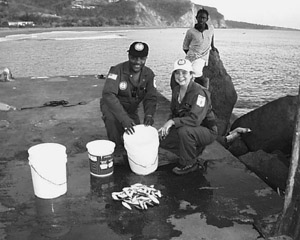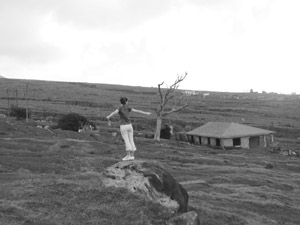Volcano Offers Minority Students Hands-On Science Training
by Andrea Cohen, MIT Sea GrantOn the Caribbean island of Montserrat, devastating volcanic eruptions in the mid-1990s sparked the exodus of more than two-thirds of the island's inhabitants. But since 2001, that same volcanic activity has been drawing a small group of researchers and students back to the island. Through a program known as RIMES (Research Integrating Molecular and Environmental Sciences), researchers pair with minority and nontraditional high school and college students to study the volcano's various effects on the island's ecosystem. The program, part of the University of Massachusetts, Lowell's Biomedical Engineering and Biotechnology Program (BMEBP), has the larger goal of encouraging such students to pursue careers in the environmental sciences. Funded by the National Science Foundation, the program also has received seed funding from MIT Sea Grant.
 RIMES director Bruce Jackson and Nancy Essen, from Mass Bay Community College, display catch of white
fish used to determine heavy metal uptake.
RIMES director Bruce Jackson and Nancy Essen, from Mass Bay Community College, display catch of white
fish used to determine heavy metal uptake."One of the reasons we think there are so few nontraditional students in science is that they're not exposed to it in those formative years,' says Bruce Jackson, RIMES director and associate professor in the BMEBP. He explains that he was something of an exception, growing up in New Haven, Conn.'s rough "Newhallville', and getting into a Yale-sponsored science program at a young age. "I was making bacterial plates when I was eight-and-a-half, and that's what hooked me,' he recalls. "Otherwise I don't know what I would have done, anything but science.'
Jackson's goal now is to help other minority students from similar backgrounds choose science too. Through the RIMES program, students sign-on for a two-year stint during which they choose a mentor and project, which involves four trips to Montserrat for field study. Those projects all take advantage of the unique opportunities afforded by the volcanic activity. They include examining the effects of ash "snowfall' on soil, coral, reptiles, and insects, and exploring the volcano's effects on weather, animals, fauna, and humans. The sudden and dramatic changes induced by the volcano also make Montserrat an excellent locale to study how organisms attempt to adapt to dramatic and abrupt changes in their environment.
 Jessica Halliley, of Finger Lakes Community College, takes in a wind gust over the buried capitol of
Plymouth.
Jessica Halliley, of Finger Lakes Community College, takes in a wind gust over the buried capitol of
Plymouth.RIMES focuses on undergraduate students, but also involves some high school students. The program targets Hispanics, Native Americans and African-Americans; women who put aside education for child-rearing or because they weren't encouraged to go into the sciences; and those with disabilities. Jackson is particularly keen to get minority men involved, noting that they comprise the greatest at-risk group in the United States. "They have high drug addiction rates, high alcoholism rates, high incarceration rates,' he explains. "We try to get them when they are trying to decide which road they're going down and grab them then.'
In fact, Jackson's aim is to grab those minority students as early as possible. "K-5 is when kids are forming their ideas about what they want to do when they grow up,' he notes. "If you ask a kid in 4th grade, 'What does it take to be a fireman?' he'll say, 'You have to learn how to climb a ladder and swing an axe and spray a hose.' They have a perception of [those professions]. If you ask them what it takes to be a scientist, they look at you with a blank stare.' To replace that blank stare with enthusiasm, Jackson has started including elementary school teachers from minority elementary schools in Cambridge, Mass. on trips to Montserrat, with the plan to develop a hands-on curriculum. "Nothing is more exciting to a kid than when something blows up,' he points out.
RIMES researchers come from a variety of universities and institutions, including New England Aquarium, University of South Carolina, Moscow State University, and University of Puerto Rico. Students are mentored throughout their two years in the program, and they also learn to teach others. "Mentoring is a big part of this, not only in terms of [students] developing a sense of self, but also in their [developing] research skills,' says Jackson. "If I teach you any research methodology and I require you to teach it to someone else, you really learn it.'
Looking ahead, Jackson hopes to transform a rudimentary structure on Montserrat into a research facility for nontraditional K-12 and college students, as well as their teachers. While the building is currently little more than a shell, Jackson is optimistic. "The best experience I ever had as a post-doc was being in a poor lab because you have to be innovative and you're able to do things that people say you can't do. You learn that the limits people place on you don't exist. It makes you a much more far-reaching thinker.'
As for the breadth and success of RIMES, Jackson is also far thinking. While quick to reel off names of students now on track in Ph.D. programs, he adds, "the indirect impact is larger than the direct impact. You never know where it ends. That's the most important part.'
